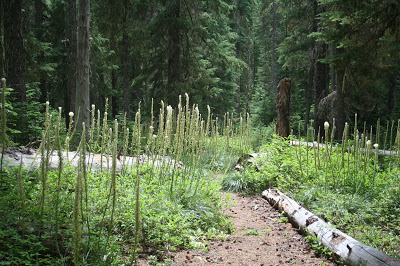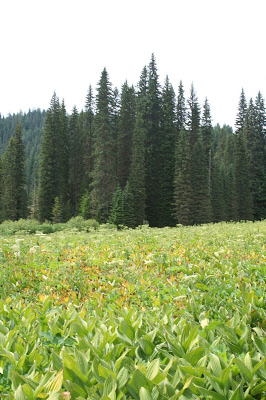It’s good to take a break every once in a while from all the things that need doing in life, and just get out in nature to re-charge. We decided we were due for such a break this weekend, and after hearing about a local Quaking Aspen Swamp for some time, I was intrigued. First of all, we don’t see many quaking aspens around here, so I wanted to know what that was all about. I had heard stories of possible wolverine sightings, another rarity for our area, AND they had me at “swamp.” Yes, Oregon is really that cool. The map showed a Quaking Aspen Botanical area after about a half mile in on the trail, so we figured with a shorter hike we could do some exploring once we got there.
The Quaking Aspen Swamp trailhead is shared with the longer Lowder Mountain Trail in the Three Sisters Wilderness. Lowder Mountain is another hike we’ve been meaning to go on, but with time constraints for 4th of July festivities, we picked the one with a shorter distance.
The trail was well maintained, and made its way down through some patches of alder and wildflowers that had already seen their heyday. Still, we did this hike at the perfect time, because the beargrass was in bloom all along the trail, which not only looked beautiful but smelled lovely.
The fibrous leaves are very tough, and traditionally have been dyed and woven into baskets by Native American tribes. They are also a popular food for bears, hence the common name. There’s a page on the USDA Forest Service website worth reading called:
The flowers, which smell a lot like lilacs, are a favorite hangout for pollinators as well. We saw quite a diverse bunch out and about along the way.
About a half mile down the trail, we saw glimpses of a large meadow, but thinking we were off on our estimated distance on the map, kept on going until we came to another meadow and the ravine where Aspen Creek flowed out and the trail continued on a steep downhill slope.
We decided this was our turn-around point, and we would go back and figure out which meadow was the actual Quaking Aspen Swamp.
With this dry summer, water levels were low enough for us to walk out into the meadow towards the sound of a creek running through, but thick scrub alders wouldn’t let us get very far in. At this point, we figured that first large meadow was probably the Quaking Aspen Swamp, so we headed back to check it out.
Once we stepped out into the meadow from the edge of the trees, we knew we had come to the right place. The meadow was filled with wildflowers and waist-high vegetation, with an open swamp out in the middle. While I saw plenty of alders, I saw no quaking aspen, and was
feeling a bit misled by the name. We also saw no wolverines, which was
probably for the best. According to plant lists I read after I got home, there are in fact quaking aspen (Populus tremuloides) growing in the Quaking Aspen Swamp. I am excited to look for them the next time I go back, and reassured to know this place was accurately named. I also found out it is the home of a carnivorous wildflower species, the Great Sundew, or Drosera anglica. I am still intrigued, and there are plenty of reasons to go back and explore this beautiful spot.
feeling a bit misled by the name. We also saw no wolverines, which was
probably for the best. According to plant lists I read after I got home, there are in fact quaking aspen (Populus tremuloides) growing in the Quaking Aspen Swamp. I am excited to look for them the next time I go back, and reassured to know this place was accurately named. I also found out it is the home of a carnivorous wildflower species, the Great Sundew, or Drosera anglica. I am still intrigued, and there are plenty of reasons to go back and explore this beautiful spot.
Directions:
From Blue River proceed east for 4 miles on Hwy 126, turn right on Rd 19
(Cougar Dam) and continue for 3 miles to Cougar Dam. At the dam turn
left onto Rd 1993 for 12 miles to Lowder Trailhead on the right.
(Cougar Dam) and continue for 3 miles to Cougar Dam. At the dam turn
left onto Rd 1993 for 12 miles to Lowder Trailhead on the right.
Here’s a link with plant lists and a map from the Mountain Plants of the Western Cascades website:
And a great blog post about the plant species encountered there:










Leave a Reply